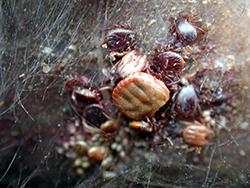- Home
- About
- Educational Resources
- Audiovisual/Teaching materials
- Livestock health, management and production
- Wildlife health, management and production
- Companion animal health
- Health management tools
- Drivers of emerging and re-emerging diseases
- Arthropod vectors
- Zoonoses
- Ecosystems and ecology
- Veterinary public health and food safety
- International trade and marketing of animal commodities and products
- Animal welfare
- Policy, planning and legislation
- CPD
- Academic programmes
- Research
- News and Events
- Links
- Contact
Tick identification

The ear of an animal parasitised by the brown ear tick, Rhipicephalus appendiculatus, the vector of the protozoan causing East Coast fever (ECF).
|
Term: 2013
|
Published: November 18, 2013 |
| Revised: July 30, 2015 |
Keywords:
| Document Title | Creator | Download | License |
|---|---|---|---|
| Complete module (html) | Prof Maxime Madder |
|
|
| Complete module (Word and PDF) | Prof Maxime Madder | ||
| Introduction | Prof Maxime Madder | ||
| Importance | Prof Maxime Madder | ||
| Sytematics/Taxonomy | Prof Maxime Madder | ||
| Seasonal occurrence / Life cycle | Prof Maxime Madder | ||
| Morphology | Prof Maxime Madder | ||
| Identification / General characteristics of tick genera (hard and soft ticks) | Prof Maxime Madder | ||
| Ticks of veterinary importance / Differential diagnosis | Prof Maxime Madder | ||
| Tick distribution | Prof Maxime Madder | ||
| References | Prof Maxime Madder | ||
| Fact sheet: Tick identification | Prof Maxime Madder | ||
| Key to identification of families and genera | Prof Maxime Madder |
Further reading
- Non Gamstop Casinos
- Non Gamstop Casinos
- Non Gamstop Casino
- Casinos Not On Gamstop
- Casino Not On Gamstop
- Casino Not On Gamstop
- Casino Online
- Non Gamstop Casino UK
- Casinos Not On Gamstop
- Casino En Ligne Fiable
- UK Casino Not On Gamstop
- Gambling Sites Not On Gamstop
- Non Gamstop Casino UK
- Casino Non Aams
- Non Gamstop Casinos
- Gambling Sites Not On Gamstop
- Non Gamstop Casinos
- Betting Site
- Meilleur Casino En Ligne France
- Best UK Slot Sites
- Casino Sites UK Not On Gamstop
- Lista Casino Online Non Aams
- Casino En Ligne
- Migliori Casino Online Italia
- Casino En Crypto
- Pari En Ligne Belgique
- Migliori Siti Scommesse Non Aams
- Meilleur Casino En Ligne
- Casino En Ligne 2026
- Bonus Sans Depot Casino
- Siti Non Aams Sicuri



